With less than a year to go until the 2014 FIFA World Cup kicks off at Arena de São Paulo in Brazil, only six of the 12 World Cup stadiums have been completed, while the remaining six struggle to meet FIFA’s December deadline.
Construction has been plagued by delays, cost overruns and safety concerns. These issues led FIFA General Secretary Jérôme Valcke to declare that the country’s World Cup preparations needed “a kick up the backside,” for which he later apologized.
Strikes by workers in several host cities have delayed work, as have incidents that have raised concerns over construction quality and safety.
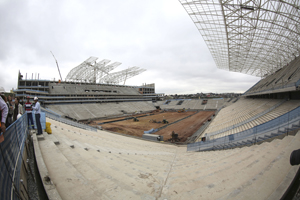 |
The stadium at São Paulo is among the World Cup venues that still have plenty of work remaining.
Photo by: Getty Images |
The friendly between Brazil and England on June 2 at Rio de Janeiro’s renovated Maracanã stadium almost didn’t happen after a judge ruled to cancel the game because of safety concerns. The stadium had largely finished a three-year, $536 million renovation, but the judge was concerned that, among other things, rubble outside the stadium could be hazardous if supporters picked up the debris during a disturbance. Eventually, however, the injunction was lifted in time for the match.
Concerns also were raised at Arena Fonte Nova in Salvador when in May a small part of the roof collapsed, apparently because of rainwater buildup. The stadium is set to host Confederations Cup matches this month.
Crews are rushing to complete work at the remaining projects before FIFA’s December deadline. That’s the case at Maracanã, the largest of all 12 venues with a capacity of 76,804 for the World Cup.
Maracanã is to Brazilian soccer fans what Yankee Stadium is to baseball fans in the United States. Originally built for the 1950 FIFA World Cup, the last time Brazil hosted the event, the stadium has undergone several renovations in its 63-year history. It was also the setting for Brazil’s arguably most painful defeat. On July 16, 1950, Uruguay defeated Brazil 2-1 in the World Cup final in front of 173,850 people.
Maracanã is one of five stadiums that have been renovated and modernized for next year’s tournament, while the other seven are newly constructed.
“[Brazil is] probably one of the most exciting, if not the most exciting market in the world when it comes to sport and entertainment today. The Brazil and entire South American marketplace is going through a renaissance with the venues that are there,” said Bob Newman, president of AEG Facilities, which has signed stadium operation deals with Maracanã as well as the World Cup venues in Recife and Curitiba.
“The venues that are being redone for the World Cup are designed and renovated with the intent of having a life after the World Cup,” Newman said. “I think that’s what’s really going to separate what happens in Brazil in 2014 versus some previous World Cup locations. There will be long lifespans for these venues, and they will be used as a catalyst for continued development in their regions.”
The Brazilian government will invest $16.6 billion in infrastructure for the 2014 World Cup, $2.9 billion alone for stadiums (see chart). After the World Cup, many of the stadiums will become home grounds for local soccer clubs, or host other sporting events and entertainment shows such as concerts.
Newman believes that the new venues will invigorate the market.
“Not only will existing events that have been touring the area go there, it will attract many new events because there are finally great venues to hold them in,” Newman said. “We certainly are in discussions with a few other locations right now. And I think between now and year-end, we’ll probably have a couple of good announcements.”
HJ Mai writes for sister publication SportsBusiness Daily Global.
World Cup venues in Brazil
Of the 12 stadium projects, six have been “delivered” to FIFA, meaning the venues are generally in working order but may still have cosmetic work remaining. The rest are scheduled to be delivered by FIFA’s December deadline. The six completed projects are those in Belo Horizonte, Brasilia, Fortaleza, Recife, Rio de Janeiro and Salvador.
Belo Horizonte
 |
| Photo by: Getty Images |
■ Stadium name: Estádio Mineirão
■ Capacity: 62,547
■ World Cup use: Group stage, round of 16, semifinal
■ Post-World Cup use: Home of Brasileiro clubs Atlético Mineiro and Cruzeiro; the venue will also host soccer matches during the 2016 Rio de Janeiro Olympic Games.
■ Year constructed: 1965
■ Design specs: One element of the renovation will allow the stadium to capture and store up to 1.7 million gallons of rainwater, which can then be resused.
Brasilia
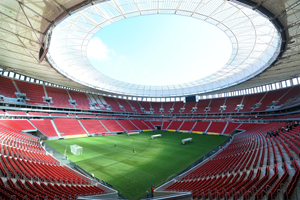 |
| Photo by: Getty Images |
■ Stadium name: Estádio Nacional de Brasilia
■ Capacity: 70,064
■ World Cup use: Group stage, round of 16, quarterfinal, 3rd place
■ Post-World Cup use: Soccer, concerts, other sporting events, soccer matches during the 2016 Rio de Janeiro Olympic Games
■ Year constructed: 2013
■ Design specs: Second-largest stadium hosting matches for the World Cup
Cuiabá
■ Stadium name: Arena Pantanal
■ Capacity: 42,968
■ World Cup use: Group stage
■ Post-World Cup use: To be determined
■ Year constructed: 2013
■ Design specs: Nicknamed “The Big Green” because of its features and building techniques that stress sustainability.
Curitiba
■ Stadium name: Arena da Baixada
■ Capacity: 41,456
■ World Cup use: Group stage
■ Post-World Cup use: Home of Brasileiro club Atlético Paranaense
■ Year constructed: 1914
■ Design specs: Additional rows of seating parallel to the pitch will help boost the stadium’s capacity to 40,000.
Fortaleza
■ Stadium name: Estádio Castelão
■ Capacity: 64,846
■ World Cup use: Group stage, round of 16, quarterfinal
■ Post-World Cup use: Concerts, soccer, other sporting events
■ Year constructed: 1973
■ Design specs: Improvements will include an underground parking lot with 1,900 spaces, executive boxes, a VIP area, and a new roof. Improved access will be provided by four exclusive bus lanes, a light rail line, and two metro rapid transit stations.
Manaus
■ Stadium name: Arena Amazônia
■ Capacity: 42,374
■ World Cup use: Group stage
■ Post-World Cup use: Multifunctional space that can play host to events such as concerts, cultural performances, exhibitions and conferences
■ Year constructed: 2013
■ Design specs: Renovations reflect the city’s proximity to the Amazon rainforest. The stadium will be enclosed by a metal structure designed to resemble a straw basket, a product for which the region is famous.
Natal
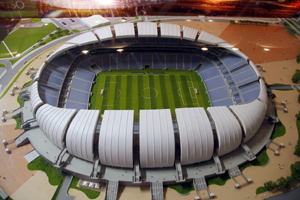 |
| Photo by: Getty Images |
■ Stadium name: Estádio das Dunas
■ Capacity: 42,086
■ World Cup use: Group stage
■ Post-World Cup use: Concerts, soccer, other sporting events, local and regional carnivals
■ Year constructed: 2013
■ Design specs: The venue’s name and undulating structure relates to the sand dunes found in the Natal region.
Porto Alegre
■ Stadium name: Estádio Beira-Rio
■ Capacity: 48,849
■ World Cup use: Group stage, round of 16
■ Post-World Cup use: Home of Brasileiro club Internacional
■ Year constructed: 1969
■ Design specs: The stadium was originally built over nearly a decade, with fans helping by donating bricks, cement and iron. For the renovation, a metal roof is being installed over the stands, ramps and turnstile areas.
Recife
■ Stadium name: Arena Pernambuco
■ Capacity: 44,248
■ World Cup use: Group stage, round of 16
■ Post-World Cup use: Home of Brasileiro club Náutico
■ Year constructed: 2013
■ Design specs: The stadium will have a solar plant with a capacity to generate energy equivalent to the average consumption of 6,000 Brazilians. It will be part of a complex also featuring restaurants, shopping centers and cinemas.
Rio de Janeiro
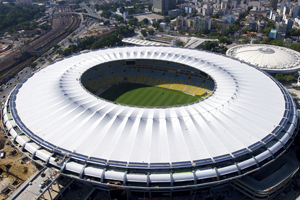 |
| Photo by: Getty Images |
■ Stadium name: Estádio do Maracanã
■ Capacity: 76,804
■ World Cup use: Group stage, round of 16, quarterfinal, final
■ Post-World Cup use: Soccer, other sporting events, concerts, soccer matches during the 2016 Rio de Janeiro Olympic Games
■ Year constructed: 1950
■ Design specs: The stadium will play host to seven games in all, more than any other venue. The lower ring of seats has been demolished and a new ring added that provides improved visibility. The historic facade will remain untouched.
Salvador
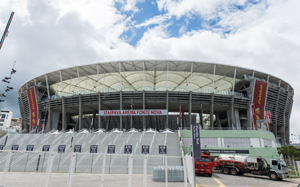 |
| Photo by: Getty Images |
■ Stadium name: Arena Fonte Nova
■ Capacity: 48,747
■ World Cup use: Group stage, round of 16, quarterfinal
■ Post-World Cup use: Home of Brasileiro club Bahia; soccer matches during the 2016 Rio de Janeiro Olympic Games; concerts; other sporting events; conferences
■ Year constructed: 2013
■ Design specs: The original stadium on the site, built in 1951, was demolished to make way for this new venue. The stadium will house a panoramic restaurant, football museum, shops, hotels and a concert hall.
São Paulo
■ Stadium name: Arena de São Paulo
■ Capacity: 65,807 (20,000 of which is temporary seating)
■ World Cup use: Group stage, round of 16, quarterfinal, semifinal
■ Post-World Cup use: Home of Brasileiro club Corinthians
■ Year constructed: 2013
■ Design specs: The stadium is intended to boost development in São Paulo’s most deprived areas and home to nearly 4 million people.
Source: SportsBusiness Journal research, FIFA









